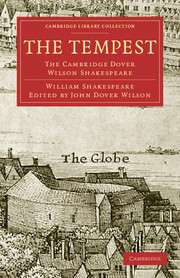THE TEMPEST: INTRODUCTION
Published online by Cambridge University Press: 07 September 2010
Summary
The Tempest is the first play in the First Folio of 1623; and this, for aught anybody knows—indeed almost certainly—was its first appearance in print. The Folio, at any rate, supplies our only text. Chronologically it is almost the last, if not the very last, that Shakespeare wrote. The Folio editors, Heminge and Condell, old friends of his and fellow-actors, may have given it pride of place for this pious reason, or possibly because it had won a striking success at Court when presented there in the winter of 1612–13, among many entertainments that graced the betrothal and nuptials of the Princess Elizabeth with the Prince Palatine Elector. John Heminge, as foreman of Shakespeare's old Company, was paid by Lord Harrington, Treasurer of the Chamber of King James I, ‘upon the councells warrant, dated at Whitehall xx0 die Mai, 1613’ his bill for producing ‘foureteene severall playes’ in the course of these festivities which were numerous and so costly as to embarrass His Majesty's exchequer. The entry (Vertue MSS) specifies these plays, and The Tempest comes sixth on the list.
It is pleasant and certainly not impossible to believe that, as Heminge and Condell have preserved it for us, this play was written-up expressly for the betrothal—and presented on Dec. 27, 1612, the betrothal night—of the incomparable Queen of Hearts whose name in story is Elizabeth of Bohemia,
design'd
Th'eclipse and glory of her kind.
Information
- Type
- Chapter
- Information
- The TempestThe Cambridge Dover Wilson Shakespeare, pp. xlv - lviPublisher: Cambridge University PressPrint publication year: 2009First published in: 1921
